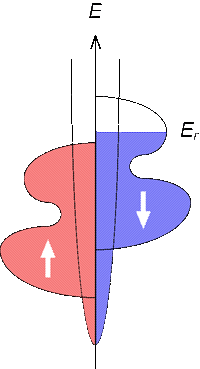Last updated: 27/12/2018
Introduction to Half-Metals
 In order to exploit 100% spin polarisation induced by spontaneous magnetisation, which is different from magnetic semiconductors (e.g., EuO and (Ga,Mn)As) based on the magnetic-filed-induced ferromagnetism due to the Zeeman splitting at low temperature, half-metallic ferromagnets have been intensively investigated recently. The half-metal possesses a bandgap at the Fermi level EF only for its minority spins, achieving 100% spin polarisation at EF [see the spin density of states (DOS) in the figure]. Four types of the half-metallic ferromagnets have theoretically been predicted so far; oxide compounds (e.g., rutile CrO2 and spinel Fe3O4), perovskites (e.g., (La,Sr)MnO3), Zinc-blende compounds (e.g., CrAs) and Heusler alloys (e.g., NiMnSb). Even though both CrO2 and La0.7Sr0.3MnO3 have been reported to show almost perfect spin polarisation at low temperature, to date there has been no experimental report on the half-metallicity at room temperature (RT), which is highly required from the viewpoint of device applications.
In order to exploit 100% spin polarisation induced by spontaneous magnetisation, which is different from magnetic semiconductors (e.g., EuO and (Ga,Mn)As) based on the magnetic-filed-induced ferromagnetism due to the Zeeman splitting at low temperature, half-metallic ferromagnets have been intensively investigated recently. The half-metal possesses a bandgap at the Fermi level EF only for its minority spins, achieving 100% spin polarisation at EF [see the spin density of states (DOS) in the figure]. Four types of the half-metallic ferromagnets have theoretically been predicted so far; oxide compounds (e.g., rutile CrO2 and spinel Fe3O4), perovskites (e.g., (La,Sr)MnO3), Zinc-blende compounds (e.g., CrAs) and Heusler alloys (e.g., NiMnSb). Even though both CrO2 and La0.7Sr0.3MnO3 have been reported to show almost perfect spin polarisation at low temperature, to date there has been no experimental report on the half-metallicity at room temperature (RT), which is highly required from the viewpoint of device applications.
For further reading Back to the Top Heusler Alloys >





